Managing Financial Resources and Decisions: Finance Report
VerifiedAdded on 2020/02/17
|17
|4875
|30
Report
AI Summary
This report comprehensively examines financial resource management and decision-making processes. It begins by identifying and evaluating various sources of finance available to both unincorporated and incorporated businesses, including internal and external options, and then assesses their implications. The report analyzes the costs associated with different financing methods, such as interest, dividends, and tax, and explores the importance of financial planning, including budgeting and the implications of inadequate financing, using Clariton Antiques Ltd. as a case study. Furthermore, it evaluates the information required for making financing decisions by venture capitalists, partners, and finance brokers. The report also delves into cash budgeting, its use in pricing decisions, and the application of investment appraisal techniques. Finally, it analyzes and compares financial statements using accounting ratios to assess a company's performance, providing a holistic overview of financial management practices and their impact on business operations and strategic decisions.
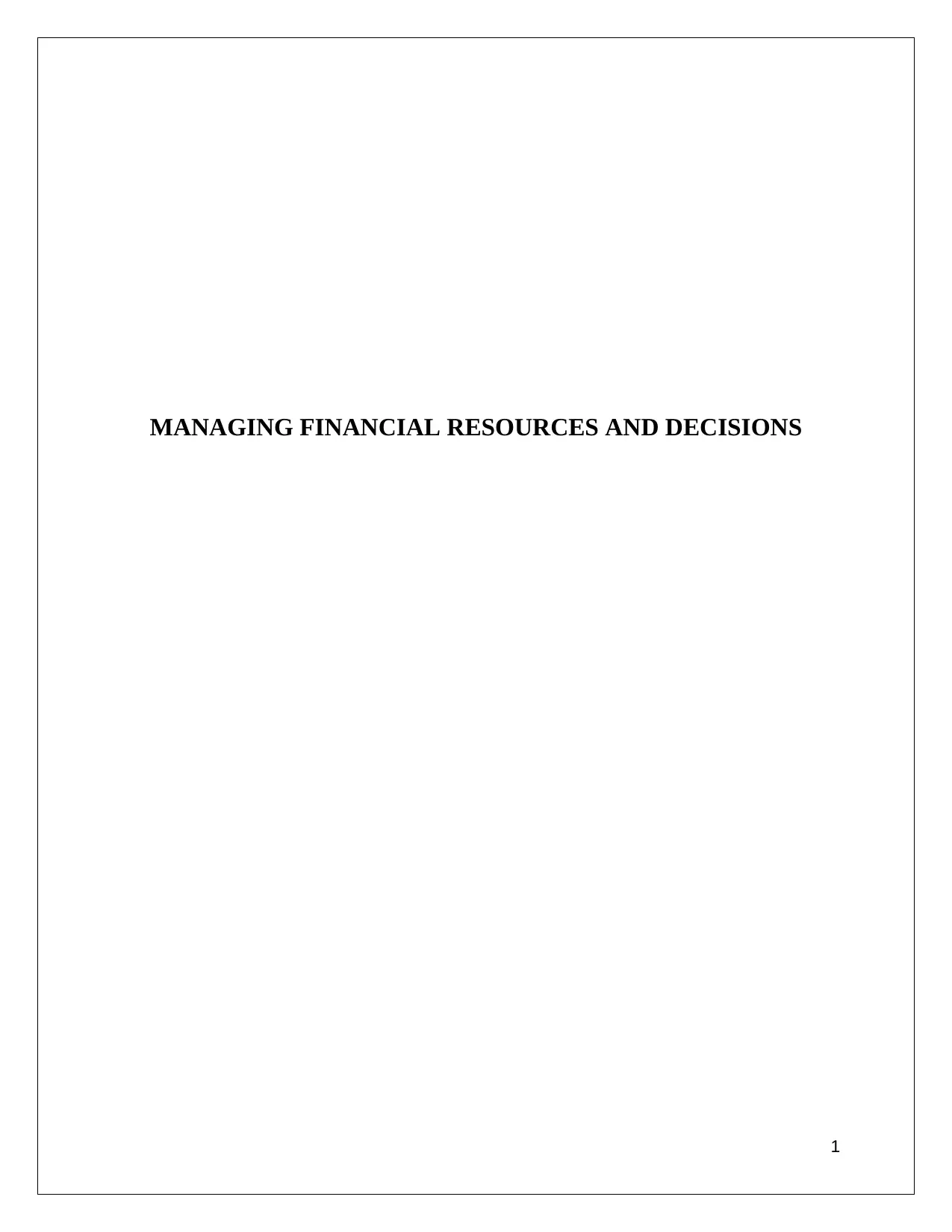
MANAGING FINANCIAL RESOURCES AND DECISIONS
1
1
Paraphrase This Document
Need a fresh take? Get an instant paraphrase of this document with our AI Paraphraser
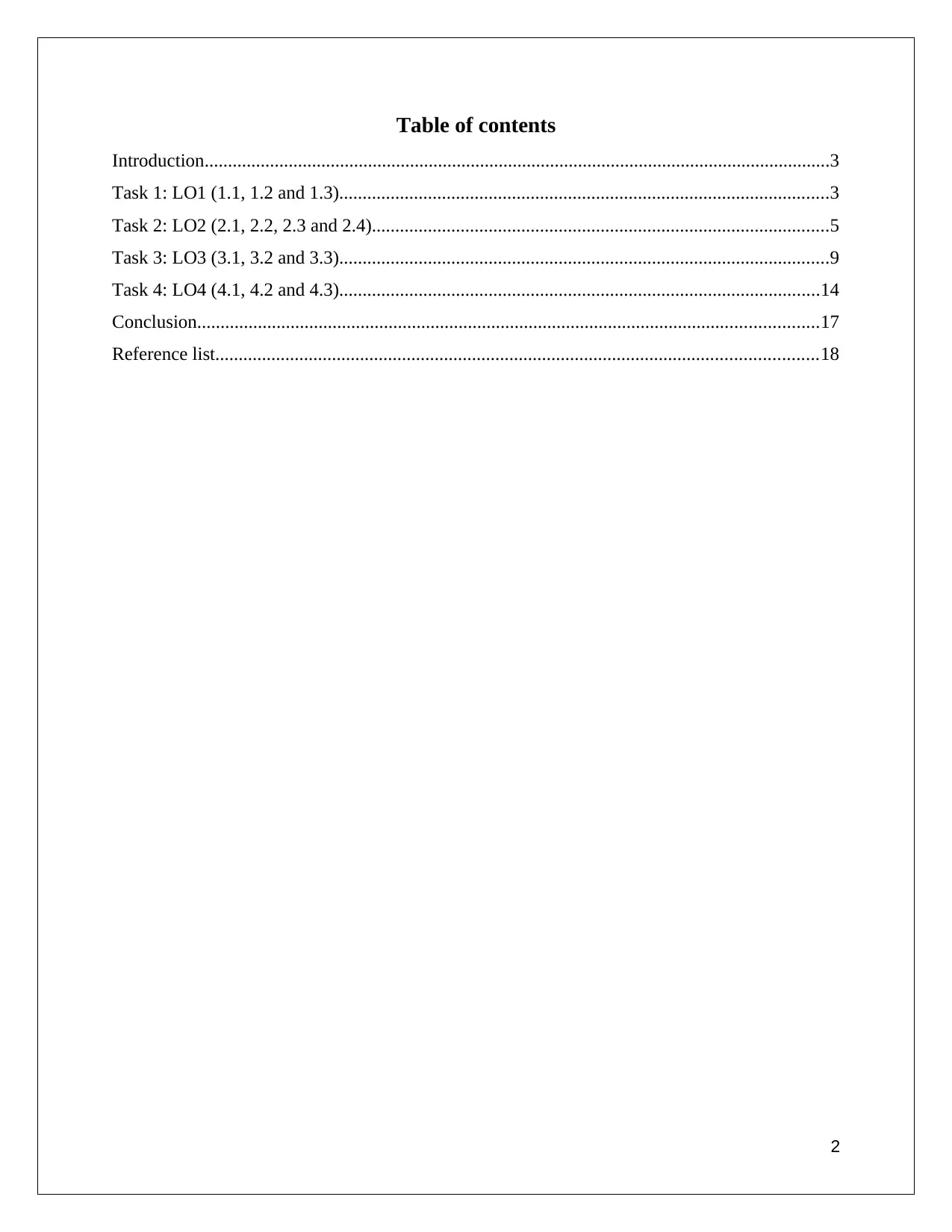
Table of contents
Introduction......................................................................................................................................3
Task 1: LO1 (1.1, 1.2 and 1.3).........................................................................................................3
Task 2: LO2 (2.1, 2.2, 2.3 and 2.4)..................................................................................................5
Task 3: LO3 (3.1, 3.2 and 3.3).........................................................................................................9
Task 4: LO4 (4.1, 4.2 and 4.3).......................................................................................................14
Conclusion.....................................................................................................................................17
Reference list.................................................................................................................................18
2
Introduction......................................................................................................................................3
Task 1: LO1 (1.1, 1.2 and 1.3).........................................................................................................3
Task 2: LO2 (2.1, 2.2, 2.3 and 2.4)..................................................................................................5
Task 3: LO3 (3.1, 3.2 and 3.3).........................................................................................................9
Task 4: LO4 (4.1, 4.2 and 4.3).......................................................................................................14
Conclusion.....................................................................................................................................17
Reference list.................................................................................................................................18
2
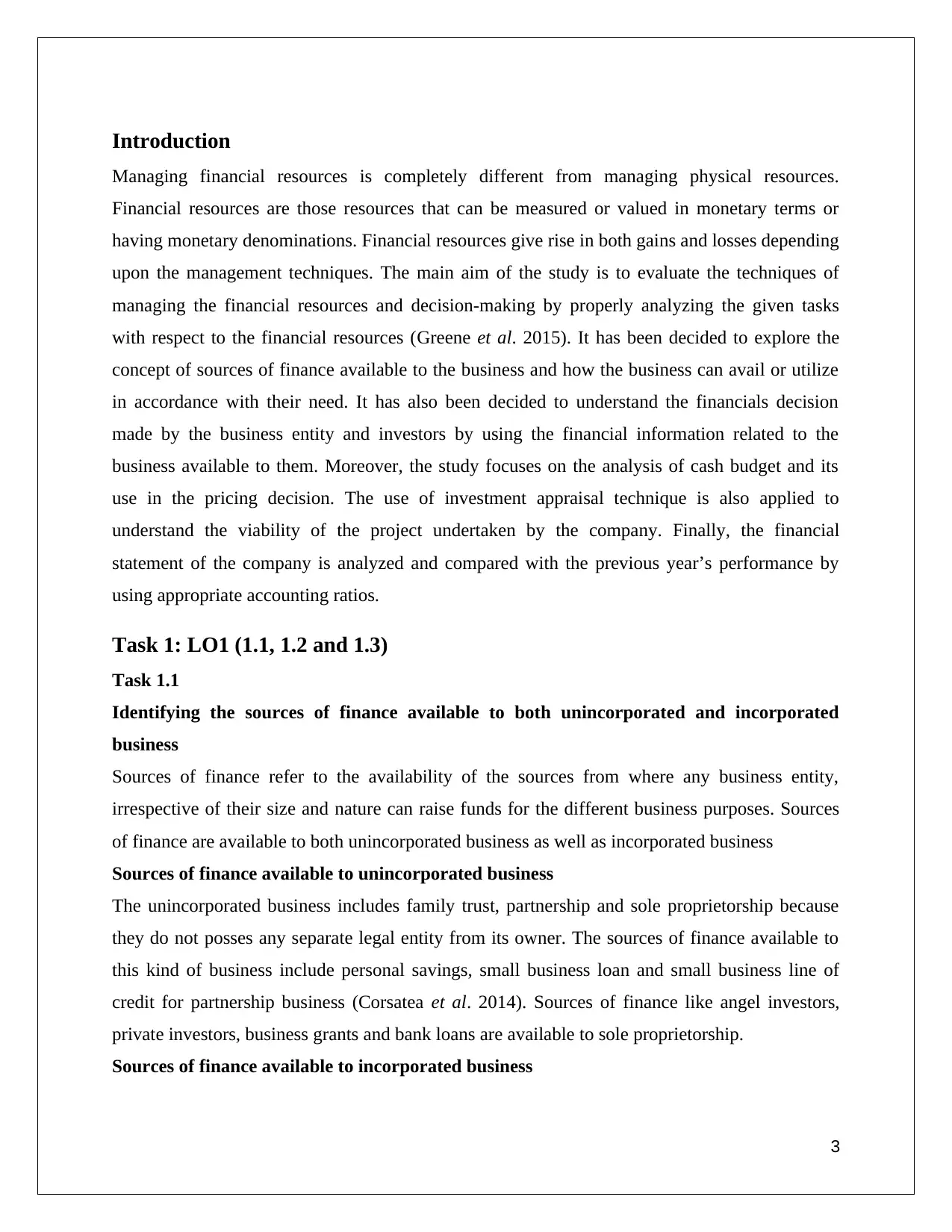
Introduction
Managing financial resources is completely different from managing physical resources.
Financial resources are those resources that can be measured or valued in monetary terms or
having monetary denominations. Financial resources give rise in both gains and losses depending
upon the management techniques. The main aim of the study is to evaluate the techniques of
managing the financial resources and decision-making by properly analyzing the given tasks
with respect to the financial resources (Greene et al. 2015). It has been decided to explore the
concept of sources of finance available to the business and how the business can avail or utilize
in accordance with their need. It has also been decided to understand the financials decision
made by the business entity and investors by using the financial information related to the
business available to them. Moreover, the study focuses on the analysis of cash budget and its
use in the pricing decision. The use of investment appraisal technique is also applied to
understand the viability of the project undertaken by the company. Finally, the financial
statement of the company is analyzed and compared with the previous year’s performance by
using appropriate accounting ratios.
Task 1: LO1 (1.1, 1.2 and 1.3)
Task 1.1
Identifying the sources of finance available to both unincorporated and incorporated
business
Sources of finance refer to the availability of the sources from where any business entity,
irrespective of their size and nature can raise funds for the different business purposes. Sources
of finance are available to both unincorporated business as well as incorporated business
Sources of finance available to unincorporated business
The unincorporated business includes family trust, partnership and sole proprietorship because
they do not posses any separate legal entity from its owner. The sources of finance available to
this kind of business include personal savings, small business loan and small business line of
credit for partnership business (Corsatea et al. 2014). Sources of finance like angel investors,
private investors, business grants and bank loans are available to sole proprietorship.
Sources of finance available to incorporated business
3
Managing financial resources is completely different from managing physical resources.
Financial resources are those resources that can be measured or valued in monetary terms or
having monetary denominations. Financial resources give rise in both gains and losses depending
upon the management techniques. The main aim of the study is to evaluate the techniques of
managing the financial resources and decision-making by properly analyzing the given tasks
with respect to the financial resources (Greene et al. 2015). It has been decided to explore the
concept of sources of finance available to the business and how the business can avail or utilize
in accordance with their need. It has also been decided to understand the financials decision
made by the business entity and investors by using the financial information related to the
business available to them. Moreover, the study focuses on the analysis of cash budget and its
use in the pricing decision. The use of investment appraisal technique is also applied to
understand the viability of the project undertaken by the company. Finally, the financial
statement of the company is analyzed and compared with the previous year’s performance by
using appropriate accounting ratios.
Task 1: LO1 (1.1, 1.2 and 1.3)
Task 1.1
Identifying the sources of finance available to both unincorporated and incorporated
business
Sources of finance refer to the availability of the sources from where any business entity,
irrespective of their size and nature can raise funds for the different business purposes. Sources
of finance are available to both unincorporated business as well as incorporated business
Sources of finance available to unincorporated business
The unincorporated business includes family trust, partnership and sole proprietorship because
they do not posses any separate legal entity from its owner. The sources of finance available to
this kind of business include personal savings, small business loan and small business line of
credit for partnership business (Corsatea et al. 2014). Sources of finance like angel investors,
private investors, business grants and bank loans are available to sole proprietorship.
Sources of finance available to incorporated business
3
⊘ This is a preview!⊘
Do you want full access?
Subscribe today to unlock all pages.

Trusted by 1+ million students worldwide
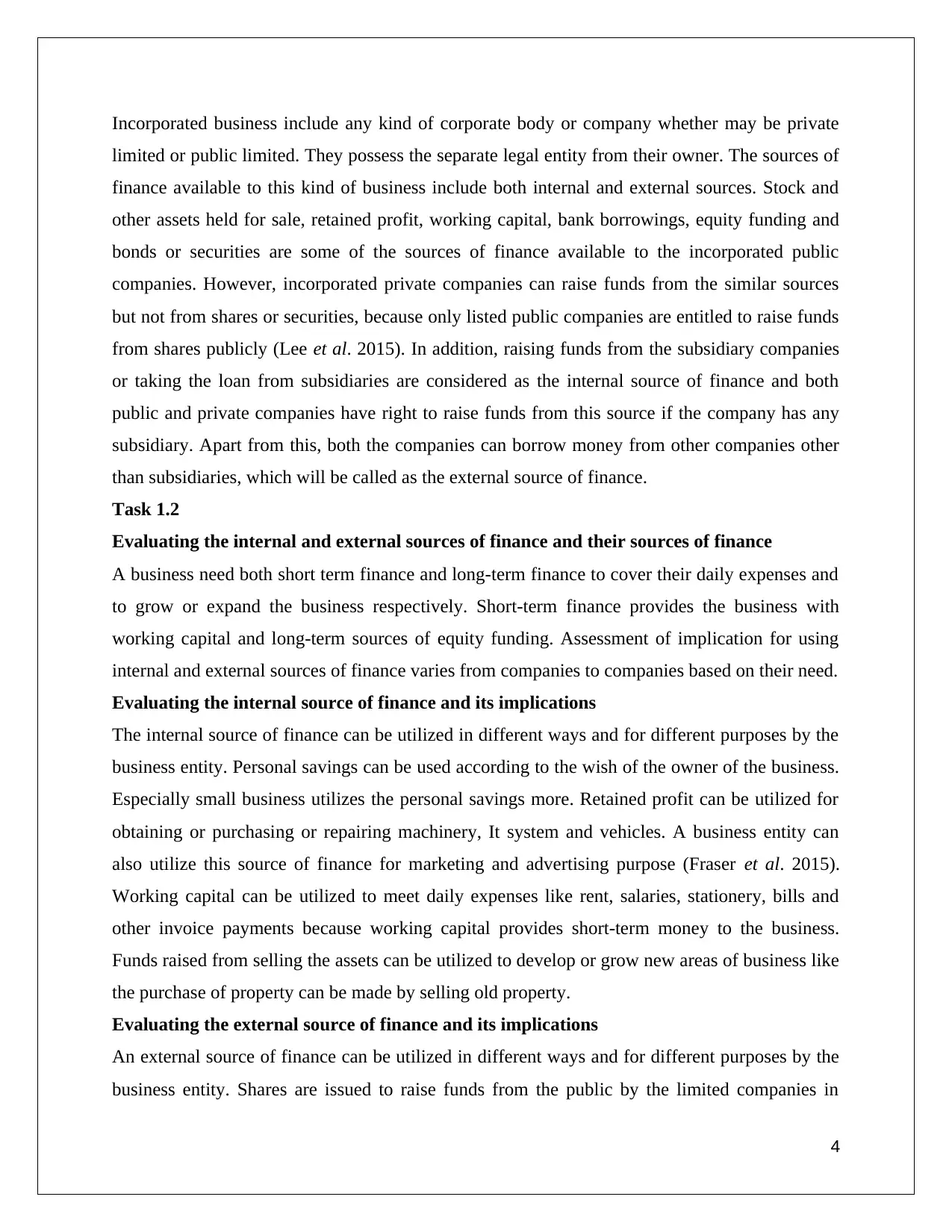
Incorporated business include any kind of corporate body or company whether may be private
limited or public limited. They possess the separate legal entity from their owner. The sources of
finance available to this kind of business include both internal and external sources. Stock and
other assets held for sale, retained profit, working capital, bank borrowings, equity funding and
bonds or securities are some of the sources of finance available to the incorporated public
companies. However, incorporated private companies can raise funds from the similar sources
but not from shares or securities, because only listed public companies are entitled to raise funds
from shares publicly (Lee et al. 2015). In addition, raising funds from the subsidiary companies
or taking the loan from subsidiaries are considered as the internal source of finance and both
public and private companies have right to raise funds from this source if the company has any
subsidiary. Apart from this, both the companies can borrow money from other companies other
than subsidiaries, which will be called as the external source of finance.
Task 1.2
Evaluating the internal and external sources of finance and their sources of finance
A business need both short term finance and long-term finance to cover their daily expenses and
to grow or expand the business respectively. Short-term finance provides the business with
working capital and long-term sources of equity funding. Assessment of implication for using
internal and external sources of finance varies from companies to companies based on their need.
Evaluating the internal source of finance and its implications
The internal source of finance can be utilized in different ways and for different purposes by the
business entity. Personal savings can be used according to the wish of the owner of the business.
Especially small business utilizes the personal savings more. Retained profit can be utilized for
obtaining or purchasing or repairing machinery, It system and vehicles. A business entity can
also utilize this source of finance for marketing and advertising purpose (Fraser et al. 2015).
Working capital can be utilized to meet daily expenses like rent, salaries, stationery, bills and
other invoice payments because working capital provides short-term money to the business.
Funds raised from selling the assets can be utilized to develop or grow new areas of business like
the purchase of property can be made by selling old property.
Evaluating the external source of finance and its implications
An external source of finance can be utilized in different ways and for different purposes by the
business entity. Shares are issued to raise funds from the public by the limited companies in
4
limited or public limited. They possess the separate legal entity from their owner. The sources of
finance available to this kind of business include both internal and external sources. Stock and
other assets held for sale, retained profit, working capital, bank borrowings, equity funding and
bonds or securities are some of the sources of finance available to the incorporated public
companies. However, incorporated private companies can raise funds from the similar sources
but not from shares or securities, because only listed public companies are entitled to raise funds
from shares publicly (Lee et al. 2015). In addition, raising funds from the subsidiary companies
or taking the loan from subsidiaries are considered as the internal source of finance and both
public and private companies have right to raise funds from this source if the company has any
subsidiary. Apart from this, both the companies can borrow money from other companies other
than subsidiaries, which will be called as the external source of finance.
Task 1.2
Evaluating the internal and external sources of finance and their sources of finance
A business need both short term finance and long-term finance to cover their daily expenses and
to grow or expand the business respectively. Short-term finance provides the business with
working capital and long-term sources of equity funding. Assessment of implication for using
internal and external sources of finance varies from companies to companies based on their need.
Evaluating the internal source of finance and its implications
The internal source of finance can be utilized in different ways and for different purposes by the
business entity. Personal savings can be used according to the wish of the owner of the business.
Especially small business utilizes the personal savings more. Retained profit can be utilized for
obtaining or purchasing or repairing machinery, It system and vehicles. A business entity can
also utilize this source of finance for marketing and advertising purpose (Fraser et al. 2015).
Working capital can be utilized to meet daily expenses like rent, salaries, stationery, bills and
other invoice payments because working capital provides short-term money to the business.
Funds raised from selling the assets can be utilized to develop or grow new areas of business like
the purchase of property can be made by selling old property.
Evaluating the external source of finance and its implications
An external source of finance can be utilized in different ways and for different purposes by the
business entity. Shares are issued to raise funds from the public by the limited companies in
4
Paraphrase This Document
Need a fresh take? Get an instant paraphrase of this document with our AI Paraphraser
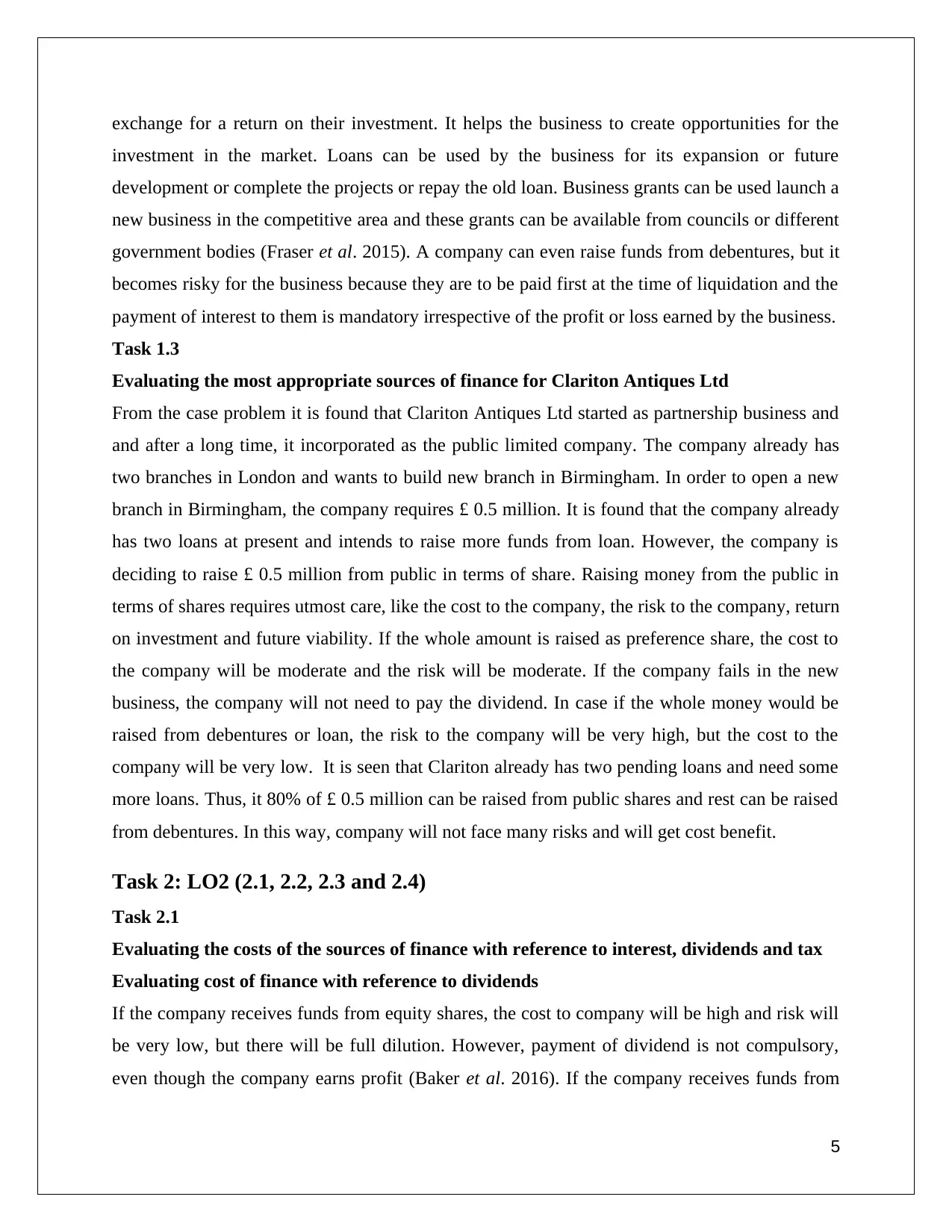
exchange for a return on their investment. It helps the business to create opportunities for the
investment in the market. Loans can be used by the business for its expansion or future
development or complete the projects or repay the old loan. Business grants can be used launch a
new business in the competitive area and these grants can be available from councils or different
government bodies (Fraser et al. 2015). A company can even raise funds from debentures, but it
becomes risky for the business because they are to be paid first at the time of liquidation and the
payment of interest to them is mandatory irrespective of the profit or loss earned by the business.
Task 1.3
Evaluating the most appropriate sources of finance for Clariton Antiques Ltd
From the case problem it is found that Clariton Antiques Ltd started as partnership business and
and after a long time, it incorporated as the public limited company. The company already has
two branches in London and wants to build new branch in Birmingham. In order to open a new
branch in Birmingham, the company requires £ 0.5 million. It is found that the company already
has two loans at present and intends to raise more funds from loan. However, the company is
deciding to raise £ 0.5 million from public in terms of share. Raising money from the public in
terms of shares requires utmost care, like the cost to the company, the risk to the company, return
on investment and future viability. If the whole amount is raised as preference share, the cost to
the company will be moderate and the risk will be moderate. If the company fails in the new
business, the company will not need to pay the dividend. In case if the whole money would be
raised from debentures or loan, the risk to the company will be very high, but the cost to the
company will be very low. It is seen that Clariton already has two pending loans and need some
more loans. Thus, it 80% of £ 0.5 million can be raised from public shares and rest can be raised
from debentures. In this way, company will not face many risks and will get cost benefit.
Task 2: LO2 (2.1, 2.2, 2.3 and 2.4)
Task 2.1
Evaluating the costs of the sources of finance with reference to interest, dividends and tax
Evaluating cost of finance with reference to dividends
If the company receives funds from equity shares, the cost to company will be high and risk will
be very low, but there will be full dilution. However, payment of dividend is not compulsory,
even though the company earns profit (Baker et al. 2016). If the company receives funds from
5
investment in the market. Loans can be used by the business for its expansion or future
development or complete the projects or repay the old loan. Business grants can be used launch a
new business in the competitive area and these grants can be available from councils or different
government bodies (Fraser et al. 2015). A company can even raise funds from debentures, but it
becomes risky for the business because they are to be paid first at the time of liquidation and the
payment of interest to them is mandatory irrespective of the profit or loss earned by the business.
Task 1.3
Evaluating the most appropriate sources of finance for Clariton Antiques Ltd
From the case problem it is found that Clariton Antiques Ltd started as partnership business and
and after a long time, it incorporated as the public limited company. The company already has
two branches in London and wants to build new branch in Birmingham. In order to open a new
branch in Birmingham, the company requires £ 0.5 million. It is found that the company already
has two loans at present and intends to raise more funds from loan. However, the company is
deciding to raise £ 0.5 million from public in terms of share. Raising money from the public in
terms of shares requires utmost care, like the cost to the company, the risk to the company, return
on investment and future viability. If the whole amount is raised as preference share, the cost to
the company will be moderate and the risk will be moderate. If the company fails in the new
business, the company will not need to pay the dividend. In case if the whole money would be
raised from debentures or loan, the risk to the company will be very high, but the cost to the
company will be very low. It is seen that Clariton already has two pending loans and need some
more loans. Thus, it 80% of £ 0.5 million can be raised from public shares and rest can be raised
from debentures. In this way, company will not face many risks and will get cost benefit.
Task 2: LO2 (2.1, 2.2, 2.3 and 2.4)
Task 2.1
Evaluating the costs of the sources of finance with reference to interest, dividends and tax
Evaluating cost of finance with reference to dividends
If the company receives funds from equity shares, the cost to company will be high and risk will
be very low, but there will be full dilution. However, payment of dividend is not compulsory,
even though the company earns profit (Baker et al. 2016). If the company receives funds from
5
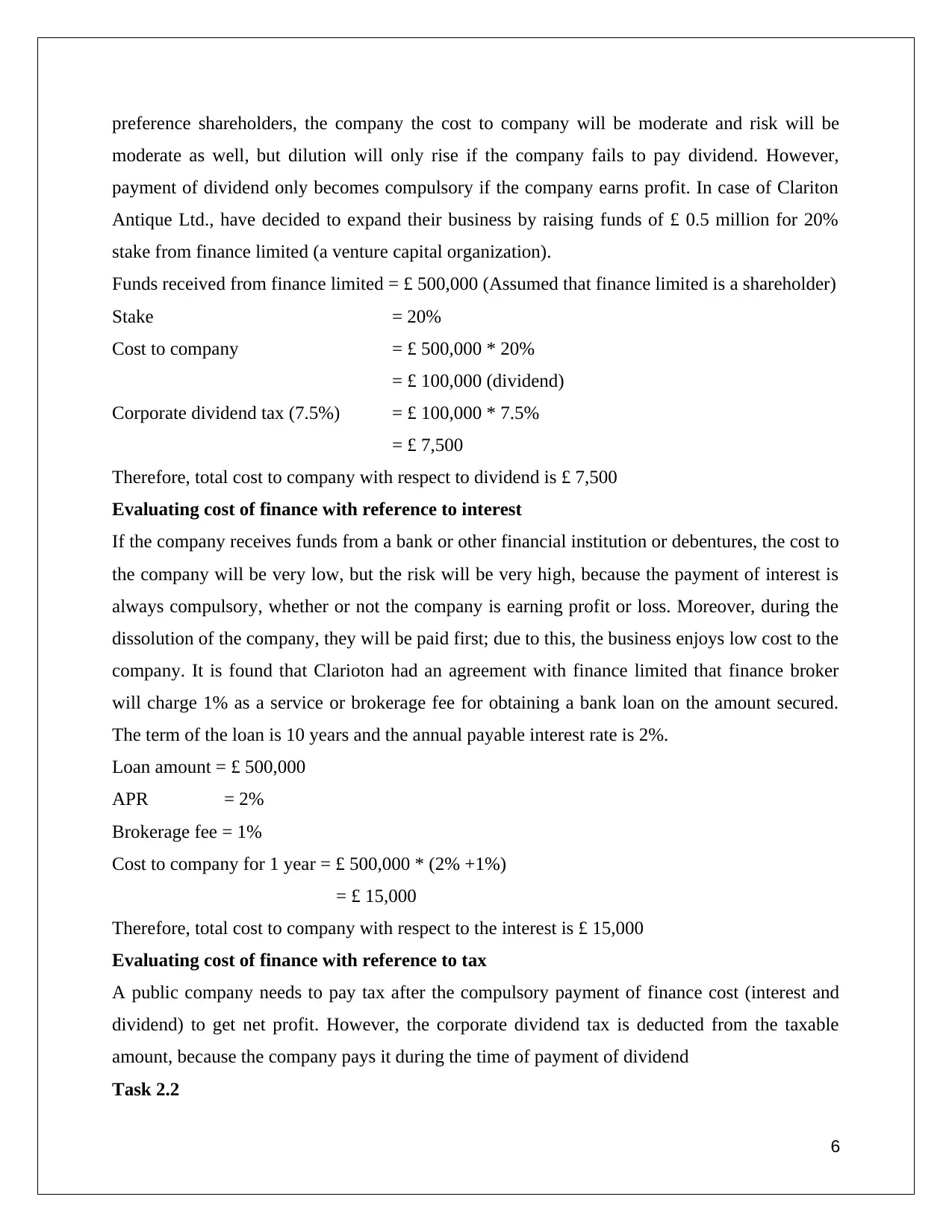
preference shareholders, the company the cost to company will be moderate and risk will be
moderate as well, but dilution will only rise if the company fails to pay dividend. However,
payment of dividend only becomes compulsory if the company earns profit. In case of Clariton
Antique Ltd., have decided to expand their business by raising funds of £ 0.5 million for 20%
stake from finance limited (a venture capital organization).
Funds received from finance limited = £ 500,000 (Assumed that finance limited is a shareholder)
Stake = 20%
Cost to company = £ 500,000 * 20%
= £ 100,000 (dividend)
Corporate dividend tax (7.5%) = £ 100,000 * 7.5%
= £ 7,500
Therefore, total cost to company with respect to dividend is £ 7,500
Evaluating cost of finance with reference to interest
If the company receives funds from a bank or other financial institution or debentures, the cost to
the company will be very low, but the risk will be very high, because the payment of interest is
always compulsory, whether or not the company is earning profit or loss. Moreover, during the
dissolution of the company, they will be paid first; due to this, the business enjoys low cost to the
company. It is found that Clarioton had an agreement with finance limited that finance broker
will charge 1% as a service or brokerage fee for obtaining a bank loan on the amount secured.
The term of the loan is 10 years and the annual payable interest rate is 2%.
Loan amount = £ 500,000
APR = 2%
Brokerage fee = 1%
Cost to company for 1 year = £ 500,000 * (2% +1%)
= £ 15,000
Therefore, total cost to company with respect to the interest is £ 15,000
Evaluating cost of finance with reference to tax
A public company needs to pay tax after the compulsory payment of finance cost (interest and
dividend) to get net profit. However, the corporate dividend tax is deducted from the taxable
amount, because the company pays it during the time of payment of dividend
Task 2.2
6
moderate as well, but dilution will only rise if the company fails to pay dividend. However,
payment of dividend only becomes compulsory if the company earns profit. In case of Clariton
Antique Ltd., have decided to expand their business by raising funds of £ 0.5 million for 20%
stake from finance limited (a venture capital organization).
Funds received from finance limited = £ 500,000 (Assumed that finance limited is a shareholder)
Stake = 20%
Cost to company = £ 500,000 * 20%
= £ 100,000 (dividend)
Corporate dividend tax (7.5%) = £ 100,000 * 7.5%
= £ 7,500
Therefore, total cost to company with respect to dividend is £ 7,500
Evaluating cost of finance with reference to interest
If the company receives funds from a bank or other financial institution or debentures, the cost to
the company will be very low, but the risk will be very high, because the payment of interest is
always compulsory, whether or not the company is earning profit or loss. Moreover, during the
dissolution of the company, they will be paid first; due to this, the business enjoys low cost to the
company. It is found that Clarioton had an agreement with finance limited that finance broker
will charge 1% as a service or brokerage fee for obtaining a bank loan on the amount secured.
The term of the loan is 10 years and the annual payable interest rate is 2%.
Loan amount = £ 500,000
APR = 2%
Brokerage fee = 1%
Cost to company for 1 year = £ 500,000 * (2% +1%)
= £ 15,000
Therefore, total cost to company with respect to the interest is £ 15,000
Evaluating cost of finance with reference to tax
A public company needs to pay tax after the compulsory payment of finance cost (interest and
dividend) to get net profit. However, the corporate dividend tax is deducted from the taxable
amount, because the company pays it during the time of payment of dividend
Task 2.2
6
⊘ This is a preview!⊘
Do you want full access?
Subscribe today to unlock all pages.

Trusted by 1+ million students worldwide
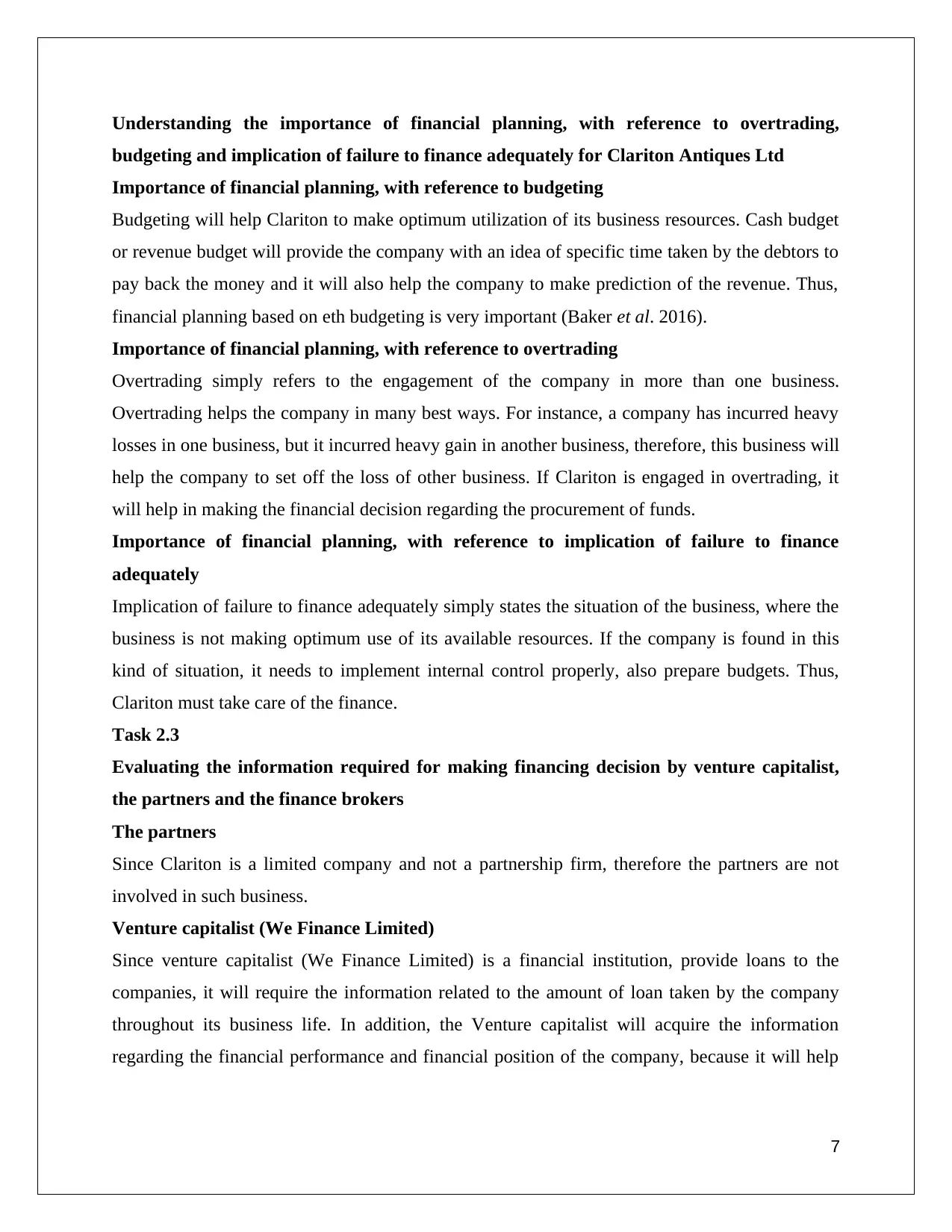
Understanding the importance of financial planning, with reference to overtrading,
budgeting and implication of failure to finance adequately for Clariton Antiques Ltd
Importance of financial planning, with reference to budgeting
Budgeting will help Clariton to make optimum utilization of its business resources. Cash budget
or revenue budget will provide the company with an idea of specific time taken by the debtors to
pay back the money and it will also help the company to make prediction of the revenue. Thus,
financial planning based on eth budgeting is very important (Baker et al. 2016).
Importance of financial planning, with reference to overtrading
Overtrading simply refers to the engagement of the company in more than one business.
Overtrading helps the company in many best ways. For instance, a company has incurred heavy
losses in one business, but it incurred heavy gain in another business, therefore, this business will
help the company to set off the loss of other business. If Clariton is engaged in overtrading, it
will help in making the financial decision regarding the procurement of funds.
Importance of financial planning, with reference to implication of failure to finance
adequately
Implication of failure to finance adequately simply states the situation of the business, where the
business is not making optimum use of its available resources. If the company is found in this
kind of situation, it needs to implement internal control properly, also prepare budgets. Thus,
Clariton must take care of the finance.
Task 2.3
Evaluating the information required for making financing decision by venture capitalist,
the partners and the finance brokers
The partners
Since Clariton is a limited company and not a partnership firm, therefore the partners are not
involved in such business.
Venture capitalist (We Finance Limited)
Since venture capitalist (We Finance Limited) is a financial institution, provide loans to the
companies, it will require the information related to the amount of loan taken by the company
throughout its business life. In addition, the Venture capitalist will acquire the information
regarding the financial performance and financial position of the company, because it will help
7
budgeting and implication of failure to finance adequately for Clariton Antiques Ltd
Importance of financial planning, with reference to budgeting
Budgeting will help Clariton to make optimum utilization of its business resources. Cash budget
or revenue budget will provide the company with an idea of specific time taken by the debtors to
pay back the money and it will also help the company to make prediction of the revenue. Thus,
financial planning based on eth budgeting is very important (Baker et al. 2016).
Importance of financial planning, with reference to overtrading
Overtrading simply refers to the engagement of the company in more than one business.
Overtrading helps the company in many best ways. For instance, a company has incurred heavy
losses in one business, but it incurred heavy gain in another business, therefore, this business will
help the company to set off the loss of other business. If Clariton is engaged in overtrading, it
will help in making the financial decision regarding the procurement of funds.
Importance of financial planning, with reference to implication of failure to finance
adequately
Implication of failure to finance adequately simply states the situation of the business, where the
business is not making optimum use of its available resources. If the company is found in this
kind of situation, it needs to implement internal control properly, also prepare budgets. Thus,
Clariton must take care of the finance.
Task 2.3
Evaluating the information required for making financing decision by venture capitalist,
the partners and the finance brokers
The partners
Since Clariton is a limited company and not a partnership firm, therefore the partners are not
involved in such business.
Venture capitalist (We Finance Limited)
Since venture capitalist (We Finance Limited) is a financial institution, provide loans to the
companies, it will require the information related to the amount of loan taken by the company
throughout its business life. In addition, the Venture capitalist will acquire the information
regarding the financial performance and financial position of the company, because it will help
7
Paraphrase This Document
Need a fresh take? Get an instant paraphrase of this document with our AI Paraphraser
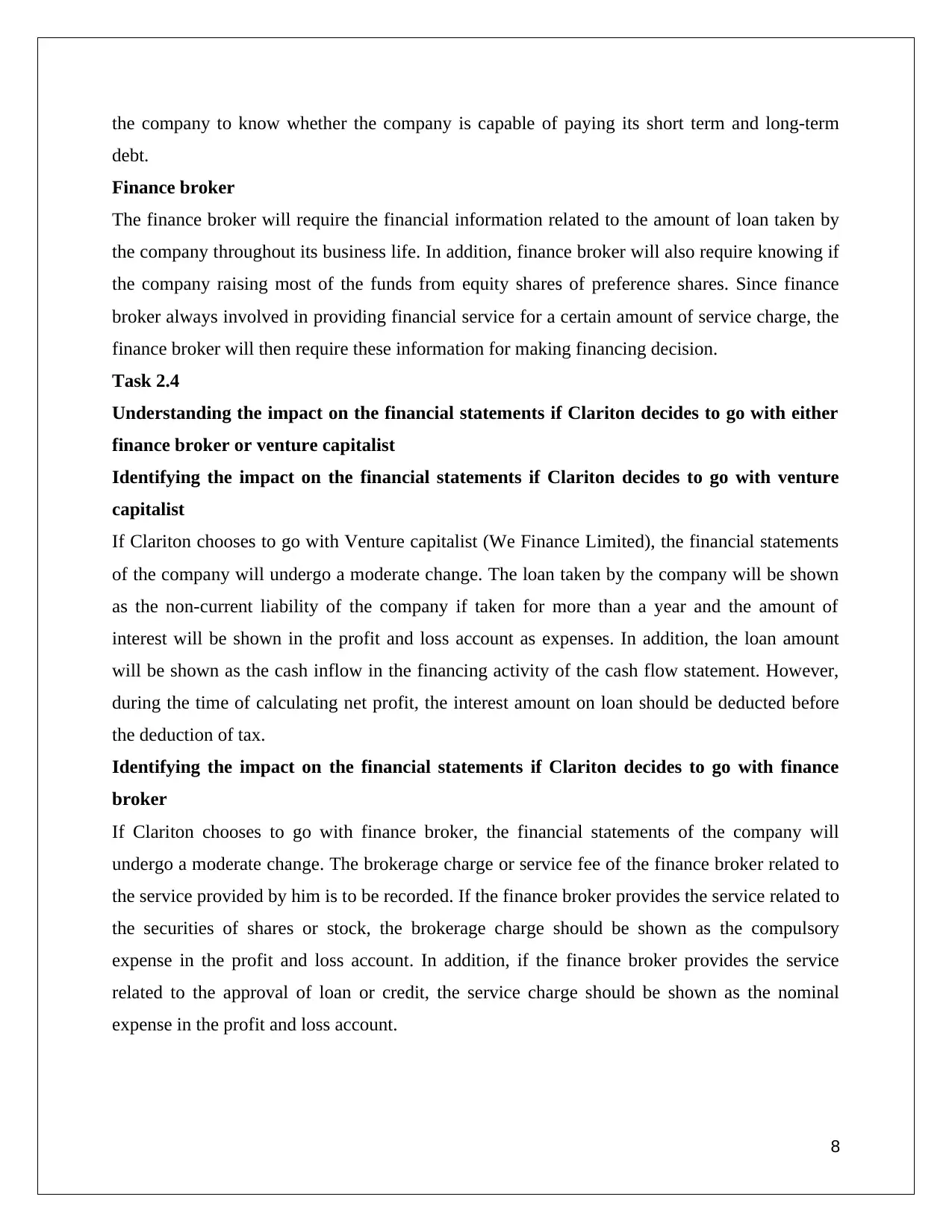
the company to know whether the company is capable of paying its short term and long-term
debt.
Finance broker
The finance broker will require the financial information related to the amount of loan taken by
the company throughout its business life. In addition, finance broker will also require knowing if
the company raising most of the funds from equity shares of preference shares. Since finance
broker always involved in providing financial service for a certain amount of service charge, the
finance broker will then require these information for making financing decision.
Task 2.4
Understanding the impact on the financial statements if Clariton decides to go with either
finance broker or venture capitalist
Identifying the impact on the financial statements if Clariton decides to go with venture
capitalist
If Clariton chooses to go with Venture capitalist (We Finance Limited), the financial statements
of the company will undergo a moderate change. The loan taken by the company will be shown
as the non-current liability of the company if taken for more than a year and the amount of
interest will be shown in the profit and loss account as expenses. In addition, the loan amount
will be shown as the cash inflow in the financing activity of the cash flow statement. However,
during the time of calculating net profit, the interest amount on loan should be deducted before
the deduction of tax.
Identifying the impact on the financial statements if Clariton decides to go with finance
broker
If Clariton chooses to go with finance broker, the financial statements of the company will
undergo a moderate change. The brokerage charge or service fee of the finance broker related to
the service provided by him is to be recorded. If the finance broker provides the service related to
the securities of shares or stock, the brokerage charge should be shown as the compulsory
expense in the profit and loss account. In addition, if the finance broker provides the service
related to the approval of loan or credit, the service charge should be shown as the nominal
expense in the profit and loss account.
8
debt.
Finance broker
The finance broker will require the financial information related to the amount of loan taken by
the company throughout its business life. In addition, finance broker will also require knowing if
the company raising most of the funds from equity shares of preference shares. Since finance
broker always involved in providing financial service for a certain amount of service charge, the
finance broker will then require these information for making financing decision.
Task 2.4
Understanding the impact on the financial statements if Clariton decides to go with either
finance broker or venture capitalist
Identifying the impact on the financial statements if Clariton decides to go with venture
capitalist
If Clariton chooses to go with Venture capitalist (We Finance Limited), the financial statements
of the company will undergo a moderate change. The loan taken by the company will be shown
as the non-current liability of the company if taken for more than a year and the amount of
interest will be shown in the profit and loss account as expenses. In addition, the loan amount
will be shown as the cash inflow in the financing activity of the cash flow statement. However,
during the time of calculating net profit, the interest amount on loan should be deducted before
the deduction of tax.
Identifying the impact on the financial statements if Clariton decides to go with finance
broker
If Clariton chooses to go with finance broker, the financial statements of the company will
undergo a moderate change. The brokerage charge or service fee of the finance broker related to
the service provided by him is to be recorded. If the finance broker provides the service related to
the securities of shares or stock, the brokerage charge should be shown as the compulsory
expense in the profit and loss account. In addition, if the finance broker provides the service
related to the approval of loan or credit, the service charge should be shown as the nominal
expense in the profit and loss account.
8
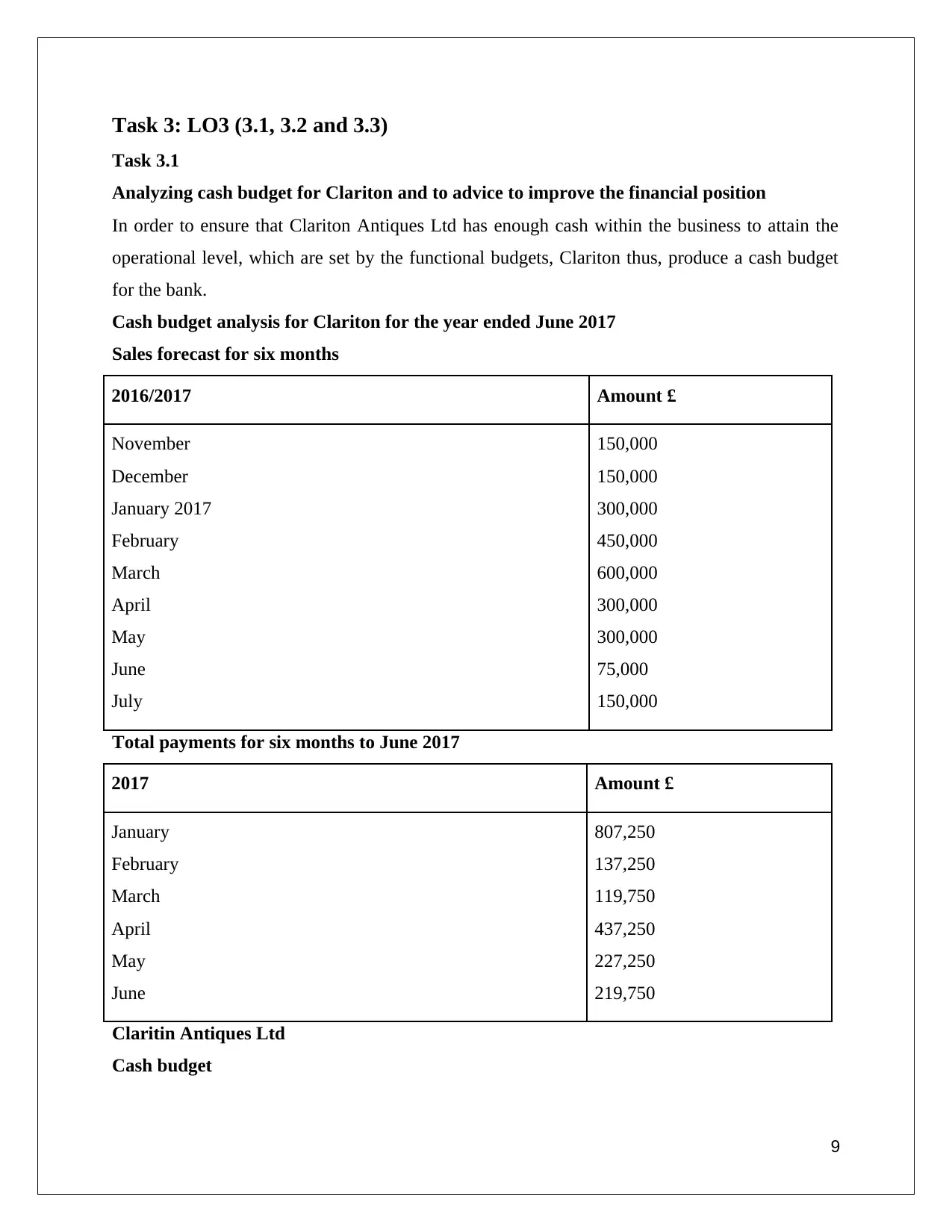
Task 3: LO3 (3.1, 3.2 and 3.3)
Task 3.1
Analyzing cash budget for Clariton and to advice to improve the financial position
In order to ensure that Clariton Antiques Ltd has enough cash within the business to attain the
operational level, which are set by the functional budgets, Clariton thus, produce a cash budget
for the bank.
Cash budget analysis for Clariton for the year ended June 2017
Sales forecast for six months
Amount £2016/2017
150,000
150,000
300,000
450,000
600,000
300,000
300,000
75,000
150,000
November
December
January 2017
February
March
April
May
June
July
Total payments for six months to June 2017
Amount £2017
807,250
137,250
119,750
437,250
227,250
219,750
January
February
March
April
May
June
Claritin Antiques Ltd
Cash budget
9
Task 3.1
Analyzing cash budget for Clariton and to advice to improve the financial position
In order to ensure that Clariton Antiques Ltd has enough cash within the business to attain the
operational level, which are set by the functional budgets, Clariton thus, produce a cash budget
for the bank.
Cash budget analysis for Clariton for the year ended June 2017
Sales forecast for six months
Amount £2016/2017
150,000
150,000
300,000
450,000
600,000
300,000
300,000
75,000
150,000
November
December
January 2017
February
March
April
May
June
July
Total payments for six months to June 2017
Amount £2017
807,250
137,250
119,750
437,250
227,250
219,750
January
February
March
April
May
June
Claritin Antiques Ltd
Cash budget
9
⊘ This is a preview!⊘
Do you want full access?
Subscribe today to unlock all pages.

Trusted by 1+ million students worldwide

Januar
y £
February £ March £ April £ May £ June £
Total 150362
.5
652662.5 236875 138250 379125 257575
Beginni
ng cash
110,00
0
Receipt
on Jan
807,250
= 5%
40362.
5
Receipt
on Feb
5% of
feb
137,250*5/1
00
= 6862.5
80% of
January
807250*80/1
00
= 645,800
Receipt
on
March
5% of
march
119750*5/10
0
= 5987.5
80% of
Februar
y
137250*80/1
00
= 109800
15% of
January
807250*15/1
10
y £
February £ March £ April £ May £ June £
Total 150362
.5
652662.5 236875 138250 379125 257575
Beginni
ng cash
110,00
0
Receipt
on Jan
807,250
= 5%
40362.
5
Receipt
on Feb
5% of
feb
137,250*5/1
00
= 6862.5
80% of
January
807250*80/1
00
= 645,800
Receipt
on
March
5% of
march
119750*5/10
0
= 5987.5
80% of
Februar
y
137250*80/1
00
= 109800
15% of
January
807250*15/1
10
Paraphrase This Document
Need a fresh take? Get an instant paraphrase of this document with our AI Paraphraser

00
=121087.5
Receipt
on April
5% of
April
437250*5/10
0
= 21862.5
80% of
march
119750*80/1
00
=95800
15% of
Februar
y
137250*15/1
00
= 20587.5
Receipt
on May
5% of
may
227250*5/10
0
=11362.5
80% of
April
437250*80/1
00
= 349800
15% of
March
119750*15/1
00
=17962.5
Receipt
on June
5% of
June
219750*5/10
0
= 10987.5
11
=121087.5
Receipt
on April
5% of
April
437250*5/10
0
= 21862.5
80% of
march
119750*80/1
00
=95800
15% of
Februar
y
137250*15/1
00
= 20587.5
Receipt
on May
5% of
may
227250*5/10
0
=11362.5
80% of
April
437250*80/1
00
= 349800
15% of
March
119750*15/1
00
=17962.5
Receipt
on June
5% of
June
219750*5/10
0
= 10987.5
11
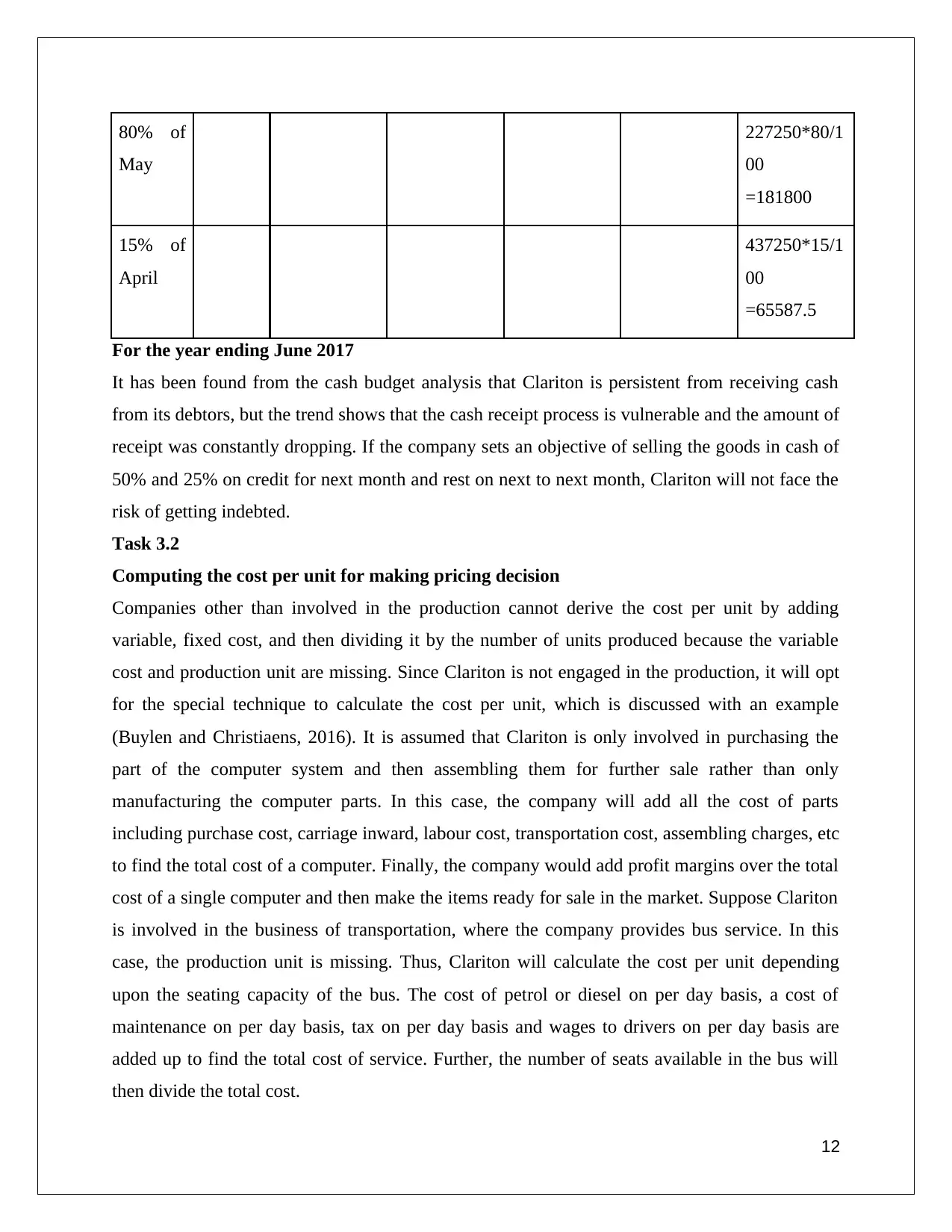
80% of
May
227250*80/1
00
=181800
15% of
April
437250*15/1
00
=65587.5
For the year ending June 2017
It has been found from the cash budget analysis that Clariton is persistent from receiving cash
from its debtors, but the trend shows that the cash receipt process is vulnerable and the amount of
receipt was constantly dropping. If the company sets an objective of selling the goods in cash of
50% and 25% on credit for next month and rest on next to next month, Clariton will not face the
risk of getting indebted.
Task 3.2
Computing the cost per unit for making pricing decision
Companies other than involved in the production cannot derive the cost per unit by adding
variable, fixed cost, and then dividing it by the number of units produced because the variable
cost and production unit are missing. Since Clariton is not engaged in the production, it will opt
for the special technique to calculate the cost per unit, which is discussed with an example
(Buylen and Christiaens, 2016). It is assumed that Clariton is only involved in purchasing the
part of the computer system and then assembling them for further sale rather than only
manufacturing the computer parts. In this case, the company will add all the cost of parts
including purchase cost, carriage inward, labour cost, transportation cost, assembling charges, etc
to find the total cost of a computer. Finally, the company would add profit margins over the total
cost of a single computer and then make the items ready for sale in the market. Suppose Clariton
is involved in the business of transportation, where the company provides bus service. In this
case, the production unit is missing. Thus, Clariton will calculate the cost per unit depending
upon the seating capacity of the bus. The cost of petrol or diesel on per day basis, a cost of
maintenance on per day basis, tax on per day basis and wages to drivers on per day basis are
added up to find the total cost of service. Further, the number of seats available in the bus will
then divide the total cost.
12
May
227250*80/1
00
=181800
15% of
April
437250*15/1
00
=65587.5
For the year ending June 2017
It has been found from the cash budget analysis that Clariton is persistent from receiving cash
from its debtors, but the trend shows that the cash receipt process is vulnerable and the amount of
receipt was constantly dropping. If the company sets an objective of selling the goods in cash of
50% and 25% on credit for next month and rest on next to next month, Clariton will not face the
risk of getting indebted.
Task 3.2
Computing the cost per unit for making pricing decision
Companies other than involved in the production cannot derive the cost per unit by adding
variable, fixed cost, and then dividing it by the number of units produced because the variable
cost and production unit are missing. Since Clariton is not engaged in the production, it will opt
for the special technique to calculate the cost per unit, which is discussed with an example
(Buylen and Christiaens, 2016). It is assumed that Clariton is only involved in purchasing the
part of the computer system and then assembling them for further sale rather than only
manufacturing the computer parts. In this case, the company will add all the cost of parts
including purchase cost, carriage inward, labour cost, transportation cost, assembling charges, etc
to find the total cost of a computer. Finally, the company would add profit margins over the total
cost of a single computer and then make the items ready for sale in the market. Suppose Clariton
is involved in the business of transportation, where the company provides bus service. In this
case, the production unit is missing. Thus, Clariton will calculate the cost per unit depending
upon the seating capacity of the bus. The cost of petrol or diesel on per day basis, a cost of
maintenance on per day basis, tax on per day basis and wages to drivers on per day basis are
added up to find the total cost of service. Further, the number of seats available in the bus will
then divide the total cost.
12
⊘ This is a preview!⊘
Do you want full access?
Subscribe today to unlock all pages.

Trusted by 1+ million students worldwide
1 out of 17
Related Documents
Your All-in-One AI-Powered Toolkit for Academic Success.
+13062052269
info@desklib.com
Available 24*7 on WhatsApp / Email
![[object Object]](/_next/static/media/star-bottom.7253800d.svg)
Unlock your academic potential
Copyright © 2020–2025 A2Z Services. All Rights Reserved. Developed and managed by ZUCOL.





